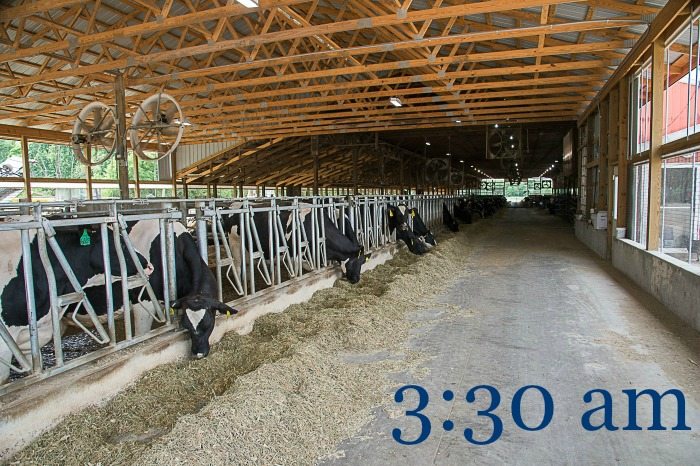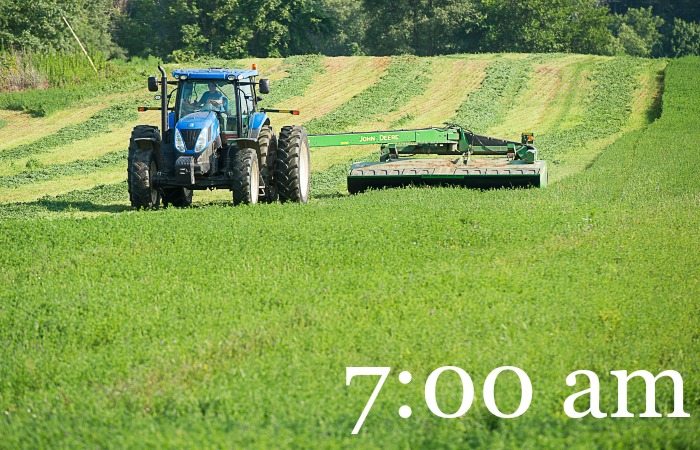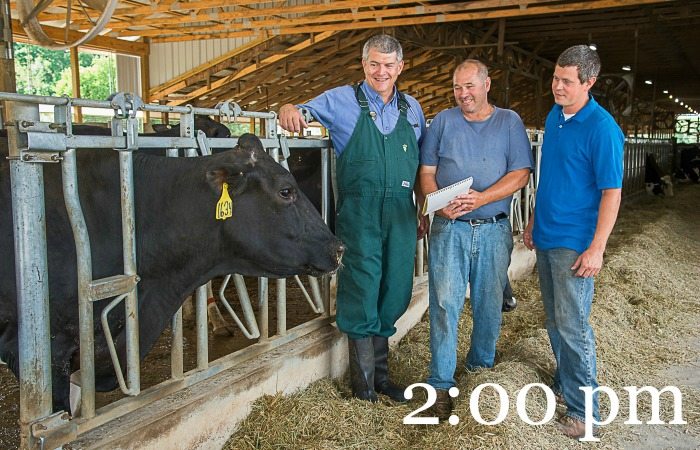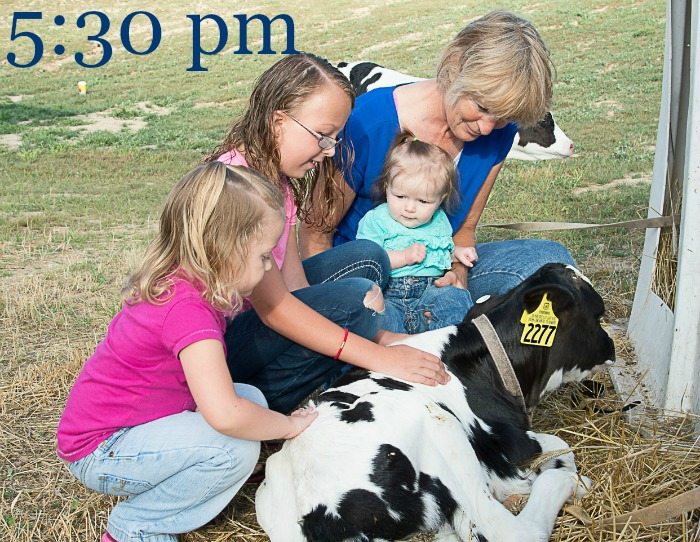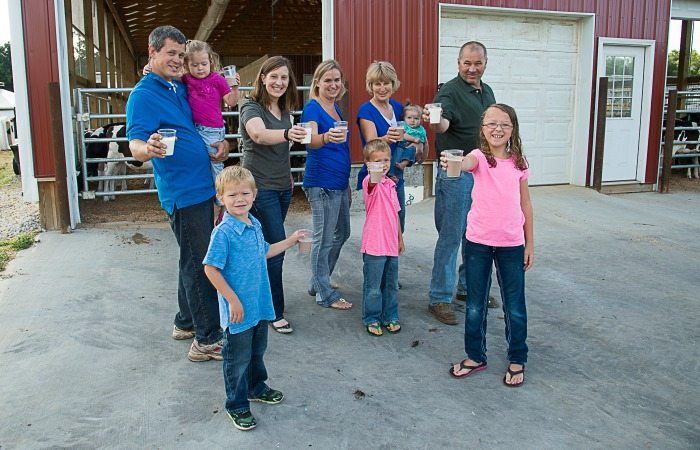Day in the Life of a Michigan Dairy Farm Family
Have you ever wondered how other people’s day unfolds, what their schedule entails and how they fit everything into 24 hours?
Follow along as I take you on a day-long journey at my family’s Michigan dairy farm where my parents and my brother care for over 400 dairy cows and calves each day.
Please note, every farm is different, just like every house and business is different. This schedule is one that works for my family, our cows and our farm setup. Each farm family will have slightly different styles and schedules but at the end of the day, we all care for our cows and the milk we provide families across the state!
3:00 am – Rise and Shine
- The day starts early, well before the sun rises.
- The first thing we do is look over the day’s weather and dress accordingly: layers in the winter to keep warm and breathable material in the summer to keep cool. Strong, durable footwear is always a necessity to protect our feet from the large animals and equipment.
3:30 am – Preparing for the Day
- When we first get to the barn, we do a quick walk through to check on all the barns.
- Our attention turns to preparing the milking parlor so we can collect the milk from the cows. All of the equipment is cleaned and sanitized after each milking shift so it’s ready for the next time. At our farm, we bring the cows into a milking parlor to allow us to collect their milk. Some of our friends have robots that milk their cows and some even take the milking units directly to the cows in their individual stalls.
3:45 am – Mixing a Gourmet Meal for the Cows
- Did you know cows have a better-balanced diet than most humans? We plan and measure everything they eat to ensure they receive the nutrients necessary to keep them healthy and help them give us wholesome milk. They eat the same ration every day that consists of corn, soybeans, hay, vitamins, and minerals. These items are all mixed together in a very large mixer wagon to make a total mixed ration, kind of like a cow casserole.
- Some farms feed their cows cotton seeds, almond hulls, expired bakery items, to name a few. Cows can digest many items that we can’t. They then turn these nutrients into milk!
- We mix all the feed for the cow’s first meal of the day so it’s ready for them to chow down when they return to their pen after being milked.
4:00 am – First Milking
- Our parlor consists of two sides where eight cows are milked on each side. The ladies walk into the parlor and line up for their turn to be milked.
- The milking process is pretty quick and usually only take about five minutes to milk each cow.
- Cows are creatures of habit so their schedule is the same every day to keep them content. Their needs come before our needs as they were entrusted to us to care for.
- The milking process consists of:
- wiping the udder clean
- dipping each of the four teats in an iodine solution to sanitize them
- wiping the iodine from each teat
- stripping milk from each teat to ensure the quality of the milk
- attaching the milking unit
- removing the milking unit when the cow is done giving milk
- applying another iodine solution to protect the teat
- Depending on the farm, their equipment and the number of cows, milking can take a few hours to complete.
5:30 am – Time to Feed the Calves
- The calves, or youngest animals on the farm are fed their 1st meal of the day: milk. Some farms purchase milk replacer which is mixed with water and fed to the calves, it contains the same nutrients as milk.
- Calves are the future of our herd, in two years each heifer calf will enter the milking herd so we want to get them off to a great start!
- Most dairy farms take the calves to a nursery-type area shortly after they are born. We do this for a number of reasons:
- to ensure the calves receive the correct nutrients by measuring the milk they receive each time they eat
- calves are born without an immune system so we need to limit their exposure to other animals
- cows are large animals, at least 1,500 pounds and calves are small, at least 80 pounds, so we want to limit the chance the small calf is injured by a large animal that is not able to see everything around them
- The calves have access to water, grain, and fresh bedding all day long.
7:00 am – Heading to the Field
- During the spring we head to the field to plant seeds that will grow into the corn and soybeans we will feed our cows for the next year. A lot of things factor into when we will plant our crops but the biggest is the weather. As we all know Michigan can throw us some pretty crazy weather conditions and during the spring we tend to see them all. The ground needs to be warm enough to help the plant grow and dry enough so we don’t get stuck in the field, which then requires quite the effort to get out.
- During the fall we harvest these crops and store them for the next year. Again, the weather plays an important factor here as the crops need to be ready for harvest to ensure they provide optimal nutrients but the field can’t be too wet.
- We “chop” the entire corn stalk to create silage, which contains all sizes of particles and lots of nutrients. This is chopped in the field and taken by large truck to our farm where it’s pushed into a big pile and a tractor drives back and forth over it to get all of the air to leave to keep the feed fresh for the next year. We then cover the pile with a large plastic tarp to keep the silage fresh and protected from the elements and to deter wild animals who wish they could eat as well as our cows.
- A few weeks after this, we will “pick” other fields of corn, meaning we only take the corn cob and remove the kernels. This corn is then dried and stored in an upright silo, those cement towers you may see as you drive by farms.
9:30 am – Adhering to Michigan’s Weather
- Cows don’t sweat so we need to keep them as cool as possible during the Michigan summer, they stay in the barn to protect them from the sun’s rays. When the temperature reaches 68 degrees, large fans turn on in the barn to provide a nice breeze over the cows to help keep them cool.
- We want our yard to look nice and welcoming so during the summer we mow the lawn and plant flowers. Everyone in my family loves fruits and vegetables so we grow a large garden of green beans, strawberries, zucchini, tomatoes, squash, raspberries, and asparagus.
- During the winter, we have to move the snow out of the driveway for our employees, the milkman, and other visitors.
10:30 am – Milkman Arrives
- After checking the milk to ensure it is free from antibiotics, the milkman loads the milk into the semi and takes to the plant where it’s pasteurized, homogenized, and either bottled for us to drink or made into cheese, butter, ice cream, etc.
- Sometimes cows get sick, just like we do. We’ve worked with our veterinarian to develop a protocol to help the cows feel better fast. If a cow does receive antibiotics, her milk does not leave the farm.
- If milk with antibiotics does leave the farm, we as farmers are responsible to pay for that milk and any other milk it comingled with. This is a costly mistake but we want to ensure the milk we all buy in the store is safe and wholesome.
- Did you know the majority of milk from my cows and cows on the other 1,500 dairy farms across Michigan stays here in the state? Milk is a local product.
- You can check to see if your milk is from a Michigan dairy farm by checking the five-digit code on the container. Milk packaged in Michigan begins with 26, followed by a three digit code that corresponds with the plant where it was pasteurized and bottled.
11:00 am – Nutritionist Visits
- Every few weeks the dairy nutritionist visits to make sure the cows are getting all the nutrients they need to continue giving us wholesome milk. During their visit, the nutritionist will take a sample of the cow’s feed and test it to ensure it remains a quality diet.
- The nutritionist will meet with us and walk through the barns to get a good look at the cows. Just looking at the cows and observing their behavior can tell us how comfortable and healthy they are.
12:00 pm – Milking Process Starts Again
- Depending on the farm, some milk 2 or 3 times each day. On our farm we milk three times a day, which means eight hours after the first shift starts, we start the process again.
- Remember, cows are creatures of habit, they know if we’re late!
1:00 pm – Mountains of Paperwork
- We keep records on everything, from the cows to the fields, to the equipment, we’re always keeping track.
- For the cows, we keep a record of:
- when they are born
- each time they are vaccinated
- if they get sick and what antibiotics they received
- when they have a calf, etc.
- We like to joke that we keep better records of our cows than we do ourselves! Do you remember the last time you had your tetanus shot? I surely don’t!
- For the crops, we keep records of which seeds are planted each year as we rotate our crop so the same crop doesn’t take all the nutrients from the field.
- We even keep track of where we spread the manure from the cows and how much is taken to each field for use as fertilizer. We want to provide only the nutrients needed in each respective field and by keeping these records we are able to monitor.
2:00 pm – Veterinarian Visits
- Every few weeks the veterinarian visits to check on the ladies to help us keep them healthy. The veterinarian will:
- check the cows to see if they are pregnant; they need to have a calf once a year to keep giving milk
- review our vaccination protocols with us
- check any cows that aren’t feeling well and help us determine a plan to get her healthy again
5:30 pm – Time to Feed the Calves Again
- The calves are ready to eat again.
- Each time we walk through the barn we watch the calves and listen to them to pick up any signs of anything out of the ordinary.
8:00 pm – Third and Final Milking of the Day
- Right on schedule, we start the 3rd milking of the day. The ladies have eaten about 100 lbs. of food during the day, drank about 50 gallons of water (the amount in a bathtub), rested almost 14 hours throughout the day and are ready to give more milk before the day ends.
Now it’s time to enjoy a delicious dairy treat! One of my favorites is One Pan Macaroni and Cheese.
